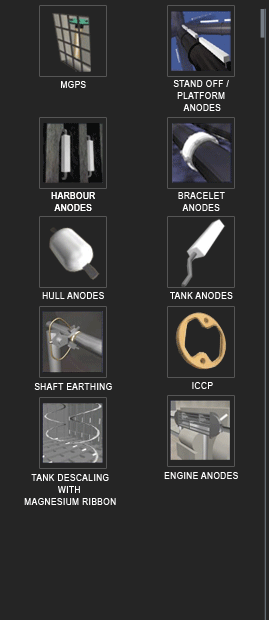

The Impressed Current Cathodic Protection system comprises of several anodes, reference electrodes and a transformer/rectifier controller power unit. The types and sizes of these components and their positions on the hull are specified according to design parameters which allow for the size of the vessel and fluctuations in the protection current likely to be encountered during sea-going service.
This type of Cathodic Protection relies on an external direct current source to be forced into the water from an inert non-wasting anode. The anode is in the electrolyte with the structure it intends to protect, and is made more positive than the structure by connecting the DC supply to both the anode and the structure.
The electrical system generates a protective current, which is then impressed onto the steel structure by means of a lead/silver alloy or a platinised titanium anode with mixed metal oxide coatings. The anodes are insulated from the hull and are surrounded by dielectric shields to prevent high voltage and current levels being imposed adjacent to the anodes. All types of anodes are provided with a cofferdam, incorporating a double gland assembly that are required by the Classification Societies, to ensure a watertight hull penetration for the anode cable.
The electrical power is taken from the main AC power, through the transformer/rectifier controller power unit, providing a low voltage DC output to the anodes. A reference cell controls the correct level of protection. The Controller Power Unit is self contained in a cabinet situated in the engine room or other convenient space. It includes solid state circuitry with PCB's for easy maintenance.
Full electrical protection is provided on input whilst output fuses are fitted in each anode circuit. All components are readily accessible within the drip proof steel enclosure.
The reference cells can be surface mounted or recessed and are fitted port and starboard; they continually monitor the potential existing between hull, seawater and reference electrode.
Both types incorporate a block of high purity zinc, which because of its robust construction and stable electrochemical characteristics, it is an ideal material for reference purposes.
The potential it measures is compared with a preset 'demand potential', with the difference or 'error signal' being utilised to adjust the DC voltage applied to the main anodes.
Whilst these measures protect the hull structure, it is important to protect the propeller, exposed shafting and the rudder. The propeller and shaft are earthed to the hull structure with a shaft slip ring and earthing brushes, making them electrically common with the hull, and the rudder is always earthed with a flexible cable. In this way, electrical continuity is established, ensuring that these components are protected by the ICCP System.


